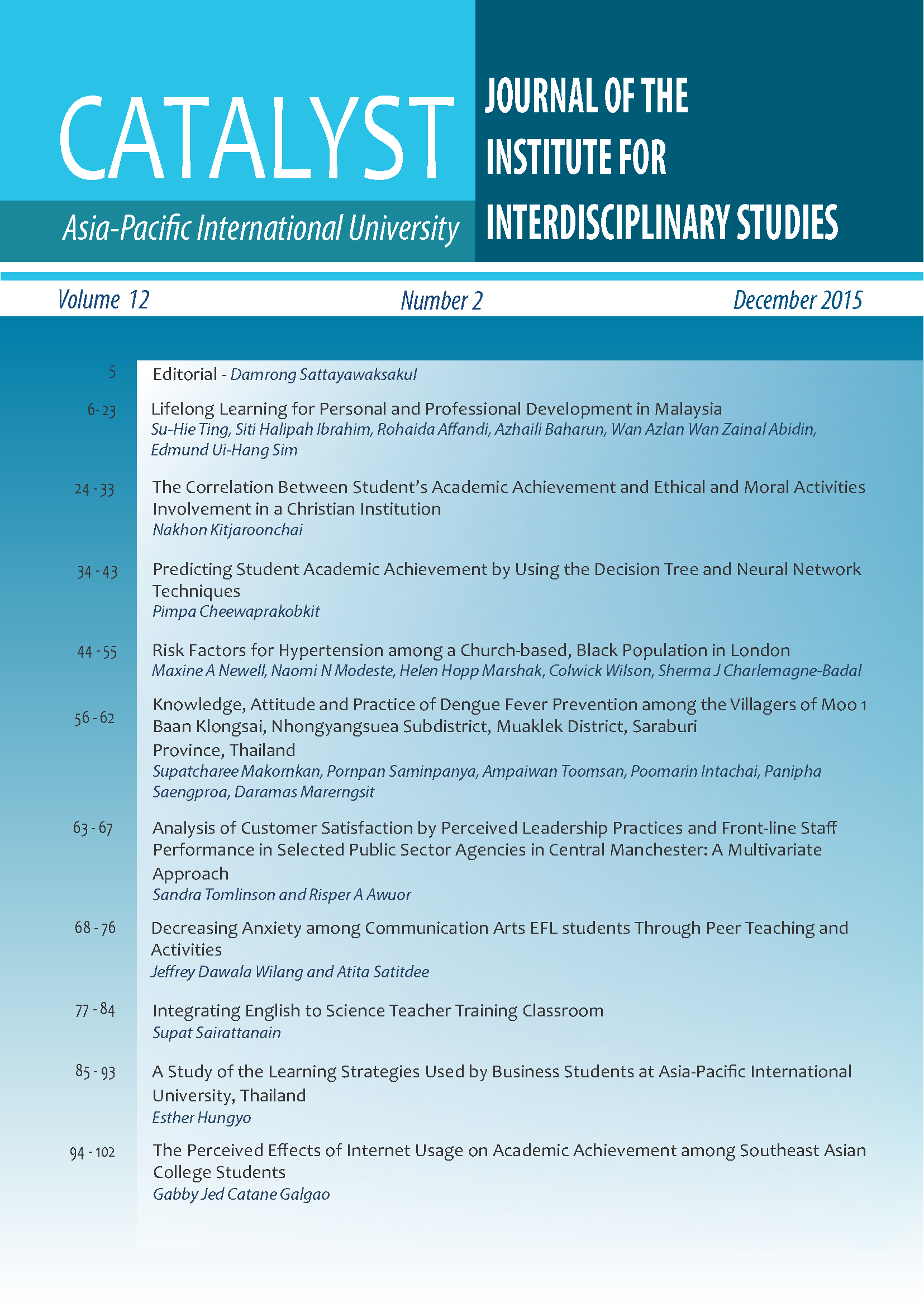Factors Affecting Reading Performance: A Study of Advanced EFL Students in Thailand
Main Article Content
Abstract
This study investigated how three factors – personal background, attitude towards reading, and motivation to read – affect the reading performance of Reading Advanced Level university students at a private international university in Thailand. Specifically, this quantitative cross-sectional survey research that involved 64 students intended to establish significant correlation between personal background and reading performance, attitude towards reading and reading performance, and motivation to read and reading performance. Further, it sought to determine the level of reading performance of the sample. The results indicated that there was a significant correlation between personal background and reading performance, and attitude towards reading and motivation to read. On the other hand, there was no significant correlation between attitude towards reading and reading performance, and motivation to read and reading performance. Further, the level of sample’s reading performance is relatively moderate.
Article Details

This work is licensed under a Creative Commons Attribution-NonCommercial-NoDerivatives 4.0 International License.
Copyright: Asia-Pacific International University reserve exclusive rights to publish, reproduce and distribute the manuscript and all contents therein.
References
Aek, P., & Lulu, L. (2011). General academic difficulties and reading and writing difficulties among Asian ESL postgraduate students in TESOL at an Australian university. RELC Journal, 42(3), 227264. doi:10.1177/0033688211421417
Anderson, N. J. (2003). Scrolling, clicking, and reading English: Online reading strategies in a second/foreign language. The Reading Matrix, 3(3).
Bastick, T. & Matalon, B. (2007). Research: New & Practical Approaches 2nd edition. Chalkboard Press. Business Education, 82(5), 282-29.
Cambria, J., & Guthrie, J. T. (2010). Motivating and engaging students in reading. The NERA Journal, 46(1), 18-29. Retrieved from http://literacyconnects.org/img/2013/03/Motivating-andengaging-students-in-reading-Cambria-Guthrie.pd
Cheng, X. (2000). Asian students' reticence revisited. System, 28(3), 435-446. conceptualizing multiple dimensions and their relations with family and demographic risk
Dahl, G. B., & Lochner, L. (2012). The impact of family income on child achievement: Evidence from the Earned Income Tax Credit. American Economic Review, 102(5), 1927-1956.
Davis-Kean, P. E., and J. S. Eccles. (2003). “The Influence of Parent Education and Family Income on Child Achievement: The Indirect Role of Parental Expectations and the Home Environment.” Paper presented at the Society for Research on Child Development, Tampa, FL.
De Guzman, A., Donisa, L., Sabio, T. (2010). Factors that affect the reading performance of Grade 1 pupils with and without preschool education in Bigaa Elementary School in Cabuyao, Laguna, S.Y. 2009-2010. Retrieved from http://www.scribd.com/doc/37191547
Dörnyei, Z. (2003). Attitudes, orientations, and motivations in language learning: Advances in theory, research, and applications. Language learning, 53(S1), 3-32.
Downey, D. B., Ainsworth-Darnell, J. W., & Dufur, M. J. (1998). Sex of parent and children's wellbeing in single-parent households. Journal of Marriage and the Family, 60(4), 878-893.
Duursma, E., Augustyn, M., & Zuckerman, B. (2008). Reading aloud to children: The evidence. Arch Dis Child, 93(7), 554-557.
Evans, M. D. R., Kelley, J., & Sikora, J. (2014). Scholarly culture and academic performance in 42 nations. Social Forces, 0(0), 1-34. doi:10.1093/sf/sou030 factors. Journal of School Psychology, 38(6), 501-523.
Feitelson, D., & Goldstein, Z. (1986). Patterns of book owndership and reading to young children in Israeli school-oriented and non-school-oriented families. Reading Teacher, 39(2). 90-115.
Goldenberg, C., Rueda, R. S., & August, D. (2008). Cross-linguistic relationships in second-language learners. In D. August & T. Shanahan (Eds.), Developing Reading and Writing in SecondLanguage Learners: Lessons from the Report of the National Literacy Panel on Language Minority Children and Youth (pp. 95-130). New York: Routledge.
Grabe, W. (2002). Reading in a second language. In Robert B. Kaplan,(Ed.), The Oxford handbook of applied linguistics, (pp. 49-59), Oxford: Oxford University Press.
Guthrie, J. (2008). Engaging adolescents in reading. Thousand Oaks, CA: Corwin Press..
Guthrie, J. T. & Wigfield, A. (2000). Effects of integrated instruction on motivation and strategy
Harb, N. & El-Shaarawi, A.(2006): Factors Affecting Students' Performance. Journal of
Henderson, A. T., & Mapp, K. L. (2002). A New Wave of Evidence: The Impact of School, Family, and Community Connections on Student Achievement. Annual Synthesis 2002. National Center for Family and Community Connections with Schools.
Javid, C. Z., & Al-Khairi, M. H. (2011). The role of pleasure reading in enhancing reading speed and reading comprehension: A case study. Arab World English Journal, 2(4), 219-256.
Kember, D. (2000). Misconceptions about the learning approaches, motivation and study practices of Asian students. Higher Education, 40(1), 99-121.
Kohl, G. O., Lengua, L. J., & McMahon, R. J. (2000). Parent involvement in school
Krashen, S. (1987). Applications of psycholinguistic research to the classroom. In M. H. Long & J. C. Richards (Eds.), Methodology in TESOL: A Book of Readings (pp. 33-44). New York: Newburry House.
Littlewood, W. (2001). Students' attitudes to classroom English learning: A cross-cultural study. Language teaching research, 5(1), 3-28.
Logan, S., Medford, E., & Hughes, N. (2011). The importance of intrinsic motivation for high and low ability readers' reading comprehension performance. Learning and Individual Differences, 21(1), 124-128.
Nation, I. S. P. (2009). Teaching ESL/EFL reading and writing. New York: Routledge.
Partin, K., & Hendricks, C. G. (2002). The relationship between positive adolescent attitudes toward reading and home literary environment. Reading Horizons, 43(1), 61.
Petscher, Y. (2010). A meta-analysis of the relationship between student attitudes towards reading and achievement in reading. Journal of Research in Reading, 33(4), 335-355.
Retelsdorf, J., Köller, O., & Möller, J. (2011). On the effects of motivation on reading performance growth in secondary school. Learning and Instruction, 21(4), 550-559. second/foreign language. The Reading Matrix (3), 1-33.
Seitz, L. (2010). Student attitudes toward reading: A case study. Journal of Inquiry & Action in Education, 3(2), 30-44. Retrieved from http://digitalcommons.buffalostate.edu/cgi/viewcontent.cgi?article=1026&context=jiae
Taylor, B. M.,Frye, B. J., & Maruyama, G. M. (1990). Time spent reading and reading growth. American Educational Research Journal, 27(2), 351-362.


